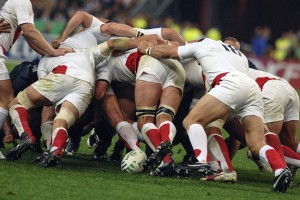
The recently published results of a Drake Foundation study spotlight the long-term risks of head injuries and concussions in rugby.
Although elite rugby has seen high rates of head injuries over recent years, little research has been conducted into the long-term neurological effects of playing the game. But concussions are the most reported injury in rugby matches, accounting for one in five injuries. That’s why the not-for-profit organisation The Drake Foundation has funded major studies that examine head impacts and concussions in rugby. The Foundation hopes to uncover any links between head injuries and neurodegenerative disease to pave the way for safer rugby practices.
This year, the journal Brain Communications published the results of one of The Drake Foundation’s studies: the Drake Rugby Biomarker Study. This study has demonstrated that sustaining head injuries in rugby matches may increase the risk of changes in brain structure. The study took place between July 2017 and September 2019 and involved the examination of 44 professional rugby players’ brain health. 21 of these players had recently sustained a mild head injury while playing.
The Drake Rugby Biomarker Study
The neuroimaging wing of the Drake Rugby Biomarker Study included players from several Premiership and Championship rugby union and rugby league teams. All players underwent an advanced MRI brain scan as part of the study, and approximately half of the players underwent a second MRI scan a year later. These advanced MRI scans are able to detect subtle structural details that standard MRIs cannot. The research team compared the rugby players’ scans to the scans of athletes who participate in non-collision sports and the scans of individuals who don’t participate in sports. The study is the first to examine brain changes in advanced MRI scans of professional rugby players.
The research team used two advanced types of MRI: diffusion tensor imaging and susceptibility weighted imaging. These scans reveal the structure of blood vessels and changes in white matter (the ‘wiring’ of the brain, which helps brain cells communicate with each other). Standard scans are more likely to miss some small structural details of blood vessels and changes in white matter.
The study concluded that 23% of the rugby players had abnormalities in their cell axons or small tears (microbleeds) in their blood vessels. Both players who had and hadn’t sustained recent head injuries displayed these abnormalities and tears. The results from the group who underwent a follow-up scan also revealed that 50% of the players had developed unexpected changes in their brains’ white matter volume. Although the long-term clinical effects of these structural changes remain unknown at present, these scans use a new technology that could be a gamechanger for monitoring player brain health.
The players also completed assessments like memory tests to analyse their brain function. The results of these tests demonstrated that players who had abnormalities in their brain structures didn’t perform any worse than players who didn’t have abnormalities. On top of this, the players provided blood, urine, and saliva samples that could reveal potential biomarkers of concussion injuries.
Imperial College London collaborated with University College London to lead the study, which the National Institute for Health Imperial Biomedical Research Centre, the Rugby Football Union (RFU), and the UK Dementia Research Institute also supported.
Next Steps to Reduce Concussion in Rugby
The research team has concluded that more work is necessary to explore the long-term effects that playing professional rugby can have on brain health. The team also emphasised that this further research should consider other health benefits of sports participation when assessing the impact of rugby-related head injuries on brain health.
It is also important to note that the impact of head injuries on professional rugby players isn’t directly comparable to the impact of head injuries on amateur players. This is because those who play at local and youth levels are less likely to sustain injuries at the same speed and impact as elite players.
Clinical Brain Health Service for Elite Rugby Players
Following the study, the RFU partnered with Premiership Rugby and independent experts to provide a specialist clinical service for retired elite rugby players to assess and manage their brain health. Male and female players aged 30-55 can now access this service.
MP Inquiry
Meanwhile, the Digital, Culture, Media, and Sport select committee of MPs has held an inquiry into sports concussions. The committee collated evidence from athletes, governing bodies, players’ unions, scientists, and doctors. This evidence suggested that governing bodies may have failed to protect player well-being and address sports-related brain health risks adequately, and called for more comprehensive action.
Updates to RFU Guidelines
As a result of research and increased attention to brain health, the RFU has announced new efforts to protect players and minimise concussions in rugby. The Union is implementing suggested limits to full contact training and trialing law changes to minimise the risk of head injuries in training and matches.
Learn more about how the Drake Rugby Biomarker Study is shaping rugby protocols.
About The Drake Foundation
The Drake Foundation has invested over £2.2 million into research that investigates the short- and long-term impact of sports-related head impacts on brain health. Many sports organisations and professionals, including the former rugby international Lewis Moody MBE, have congratulated The Drake Foundation’s work.
The Foundation is committed to understanding and improving the health and welfare of those affected by head impacts and injuries, including sports players and those who have suffered intimate partner violence (IPV). The Foundation’s other studies include the BRAIN Study, the Drake Football Study, the Drake Football Concussion Study, the HEADING Study, and the Drake IPV Study,.
Read more:
Research Reveals Concussions in Rugby Can Cause Changes in Player Brain Structure
